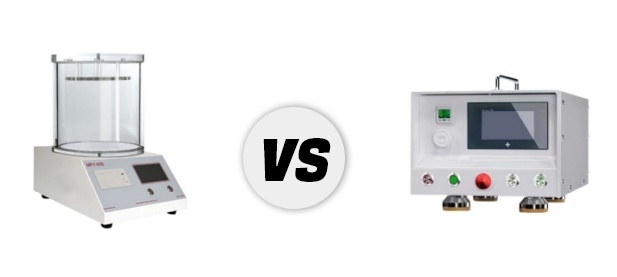In manufacturing, automotive, electronics, and pharmaceutical industries, leak testing is a critical quality control step that prevents product failures, ensures safety, and complies with industry standards. Two of the most widely used tools for this purpose are vacuum leak testers and air leak testers—but while both detect leaks, their working principles, performance characteristics, and ideal use cases differ significantly. Understanding these differences is essential for businesses to select the right equipment for their specific needs.
Leak Tester's Different Working Principles
The biggest differences between vacuum leak tester and air pressure leak tester lie in the pressure environment they use to detect leaks. This foundational difference shapes their capabilities, accuracy, and suitability for different products.
Vacuum Leak Tester
Vacuum leak testers operate by first creating a vacuum (negative pressure) environment inside the test part or a sealed chamber surrounding the part. Below is its operational workflow:
First, the test product is hermetically sealed to isolate the area to be tested. Next, a vacuum pump extracts air from the sealed space, reducing the pressure to a preset level (typically between 1 mbar and 100 mbar, depending on the application scenario). Once the target vacuum level is reached, the vacuum pump shuts down, and the system monitors pressure fluctuations over a set period. If a leak exists, air will rush into the low-pressure space, causing the internal pressure to rise. Testers then compare the pressure rise value against a preset threshold. If the pressure rise exceeds the threshold, the component is deemed "leaky"; if it does not, the component is considered qualified.
Air Leak Tester
Air leak testers, by contrast, use compressed air (positive pressure) to pressurize the test part. Their workflow is the opposite of vacuum testers but equally straightforward:
After the product is sealed, compressed air is pumped into it to reach a specific positive pressure (ranging from 0.1 bar to 10 bar, depending on the type of product). Following pressurization, the system pauses to allow the pressure to stabilize. The system then monitors pressure drops over a set period. If a leak exists, the internal pressure will decrease as air escapes to the outside. The tester measures either the pressure drop rate or the total pressure loss. If the pressure drop exceeds the allowable limit, the component is deemed unqualified; otherwise, it is considered qualified.
Different Performance Between Two Leak Testers
To choose types of leak testers, enterprises must evaluate them against critical performance criteria, including detection speed, component compatibility across different products, environmental tolerance and cost. SISCO has compared their advantages and limitations as follows:
Test Speed
Vacuum leak testers are relatively slower, as creating a vacuum and stabilizing the pressure generally takes more time (typically 10–30 seconds per part). Air leak testers use air for pressurization, which is faster; the test time per part ranges from 2–15 seconds (making them ideal for high-volume production lines).
Component Compatibility
Vacuum leak testers are suitable for detecting high-precision components that can withstand vacuum, such as those used in electronics and semiconductors, refrigeration and HVAC, medical devices and instruments, and aerospace and defense industries. However, they pose risks for flexible components (e.g., plastic products). Air leak testers, on the other hand, are ideal for components on assembly lines that require speed and efficiency—such as those in automation, packaging materials, household appliances, and industrial manufacturing. They are also suitable for soft and fragile components.
Environmental Tolerance
Vacuum leak testers are sensitive to external pressure and temperature changes (e.g., air drafts in factories) — a climate-controlled testing area may be required. Air leak testers have lower sensitivity to external conditions, as atmospheric pressure fluctuations have minimal impact on positive-pressure measurements.
Cost
Vacuum leak testers have higher upfront costs (especially helium-based models), and they also require certain maintenance costs because vacuum pumps need regular overhauls. Air leak testers, however, have lower upfront costs—compressed air systems are more commonly available and easier to maintain.
Vacuum Leak Tester or Air Leak Tester, which is better?
- Assess Your Product’s Physical Properties: Assess whether your components can withstand a vacuum. If they are made of flexible materials (e.g., rubber hoses) or fragile materials (e.g., thin plastic), using an air leak tester is safer.
- Consider Production Volume: High-volume lines (e.g., 1,000+ parts per hour) need the speed of an air leak tester. Low-volume, high-value parts (e.g., aerospace components) can justify the slower pace of a vacuum leak tester.
- Calculate Total Cost of Ownership (TCO): Beyond upfront cost, factor in maintenance (vacuum pumps vs. air compressors), energy use (vacuum pumps consume more power), and training (helium systems need skilled operators).
Conclusion
Two of leak testers are both essential tools for quality control, but they serve distinct purposes. Vacuum testers deliver unmatched sensitivity for critical applications like medical devices or aerospace, while air testers offer speed and cost-effectiveness for high-volume industries like automotive or packaging.
By understanding their working principles, performance differences, and ideal use cases, you can avoid costly mistakes (e.g., using a vacuum tester on flexible parts) and ensure their leak testing process meets safety, compliance, and efficiency goals. Ultimately, the right choice is the one that aligns with your product’s needs and long-term operational priorities. sisco.com online shop offers a variety of leak testers, and we hope you can find the right one for your needs.

